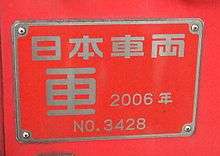Nippon Sharyo
Nippon Sharyo, Ltd. (日本車輌製造株式会社, Nippon Sharyō Seizō kabushiki gaisha, literally "Japan Vehicles Manufacture Company"), formed in 1896, is a major rolling stock manufacturer based in Nagoya, Japan. In 1996, it abbreviated its name to "日本車両" Nippon Sharyō. Its shortest abbreviation is Nissha "日車". It was a listed company on Nikkei 225 until 2004. It is listed on the Tokyo Stock Exchange and Nagoya Stock Exchange as ticker 7102. In 2008, Central Japan Railway Company (JR Central) became the majority shareholder (50.1%) of the financially struggling Nippon Sharyo making the firm a "consolidated subsidiary" of JR Central. In July 2012 Nippon Sharyo USA started production in their new facility in Rochelle, Illinois. The facility closed at the end of October 2018 due to a lack of orders.[2][3]
_02.jpg) Nippon Sharyo's headquarters | |
Native name | 日本車輌製造株式会社 |
|---|---|
Romanized name | Nippon Sharyō Seizō kabushiki gaisha |
Formerly | Nippon Sharyo Seizo Kaisha, Ltd. |
| Public KK | |
| Traded as | TYO: 7102 NAG: 7102 |
| ISIN | JP3713600009 |
| Industry | Railways |
| Founded | Japan, September 1896 |
| Headquarters | Nagoya, Japan |
Key people | Tsutomu Morimura (President & CEO), Mikio Tsuge (Senior Managing Director of Nippon Sharyo, Ltd and Chairman of Nippon Sharyo USA, Inc.) |
| Products | Rolling stock |
| Revenue | 101,094,000,000 Japanese yen[1] (2017) |
| -5,104,000,000 Japanese yen[1] (2017) | |
| -5,114,000,000 Japanese yen[1] (2017) | |
| Total assets | 129,194,000,000 Japanese yen[1] (31 March 2017) |
Number of employees | 1,850 (September 2018) |
| Parent | JR Central (50.1%) |
| Website | www |
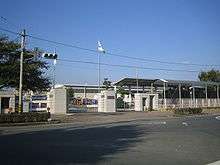
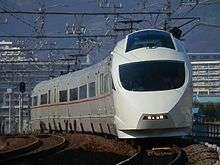
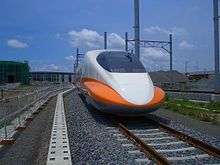
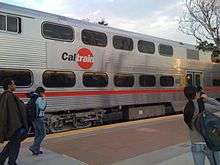
_Metra_Station.jpg)
.jpg)
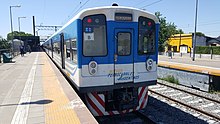
Notable projects

- Shinkansen ("bullet train") trainsets
- Odakyu Electric Railway trainsets
- Linimo maglev train
- Keisei Electric Railway trainsets
- Keisei 3000 series
- Keisei 3050 series
- Keisei AE100 series
- Keisei AE series
- Nearly all Meitetsu trains

- SuperVIA Série 500
- Porto Alegre Metro EMUs
.svg.png)
- Toronto Transit Commission work cars
- RT10 Garbage car 1967 - Tokyo Rose retired in 2000 and scrapped
- RT12 Electric locomotive 1968 and retired 2009
- RT13 Centre cab crane 1968 - with car and crane cabs
- RT22 Flat car 1973 - formerly wash car RT-17 and rebuilt 1996
- RT54 flat car 1973
- Union Pearson Express Diesel Multiple Units
- Nippon Sharyo DMU (jointly with Sumitomo Corporation) 2014

- Manila Light Rail Transit System Line 1 (jointly with Kinki Sharyo)
- LRTA Class 1200

- Taiwan Railway Administration
- Taipei Metro
- C371
- Taiwan High Speed Rail

- Next Generation Bi-Level Passenger Rail Car
- Los Angeles County Metro Rail P865 and P2020
- Northern Indiana South Shore Line EMUs
- Maryland MARC Train single-level push-pull coaches (jointly with Sumitomo Corporation)
- Chicago Metra bi-level gallery cars[6] and Highliner rail cars
- Virginia VRE bi-level gallery cars
- San Francisco Bay Area Caltrain bi-level gallery cars
- Sonoma–Marin Area Rail Transit Nippon Sharyo DMU (jointly with Sumitomo Corporation)[6]

I.F.E EMUs Working on Caracas-Cua commuter line Railway System Ezequiel Zamora (Central)

Rheostatic series (KRL Rheostatik Mild Steel and Stainless) (The train was also made by Kawasaki Heavy Industries and Hitachi):
- Built 1976: Has 2 doors and uses mild steel body types
- Built 1978,1983,1984: Has 3 doors and uses mild steel body types
- Built 1986,1987: Has 3 doors and uses stainless steel body types
All Rheostatic EMUs have stopped operating in the Jabodetabek lines and is currently waiting to be scrapped.
Shinko Diesel Multiple Units (a.k.a. KRD MCW 301 and KRD MCW 302) are used for short-distance lines such as Surabaya-Lamongan, Surabaya-Sidoarjo, etc.
- KRD MCW 301 Built 1976: Has 2 doors and uses mild steel body types
- KRD MCW 302 Built 1978,1980,1982,1987: Has 3 doors and uses mild steel body types
KRD MCW 301 and 302 initially uses the Shinko DMH17H engine and Niigata TCR 2.5 transmission
Note: The DMUs built in 1976 are now used as regular loco-hauled trains without engines. The DMUs made in 1978, 1980, & 1982 upwards are refurbished with a Cummins Engine (NT885-R) and Voith turbo (T211re.3) transmission.
The new rolling stock, known as the MRTJ 1000, was built specifically for the Jakarta MRT[7]
Wartime involvement
Nippon Sharyo, in 1936, built the JNR Class C56 steam locomotive number C56 31, which was used in 1943 to open the infamous Thai-Burma Railway, as stylized in the movie The Bridge Over the River Kwai, built by over 100,000 Allied POW and other slave labourers. This restored steam engine now sits in the foyer of the Yasukuni War Museum in Tokyo. Japanese veterans groups raised funds to return the locomotive from Burma to Japan in 1979.
During World War II, Nippon Sharyo, like many major Japanese companies, drew upon prisoner of war labour to maintain war production. The POW camp at Narumi provided Allied POW forced labour for Nippon Sharyo.[8]
References
- http://www.n-sharyo.co.jp/finance/188thAnnualReport.pdf.
- http://m.railjournal.com/index.php/north-america/nippon-sharyo-to-close-us-plant.html
- "JR Central takes majority stake in train builder". Railway Gazette International. 1 October 2008.
- "Archived copy". Archived from the original on 2012-07-16. Retrieved 2012-03-11.CS1 maint: archived copy as title (link)
- "Taiwan Railway Administration orders tilting trains". Railway Gazette International. 6 January 2011.
- "Sonoma-Marin orders commuter DMU cars". Railway Gazette International. 20 December 2010.
- http://industri.bisnis.com/read/20161023/98/595095/nippon-sharyo-produsen-shinkasen-sekaligus-kereta-mrt-jakarta
- Narumi POW Camp Retrieved 27 June 2010.
